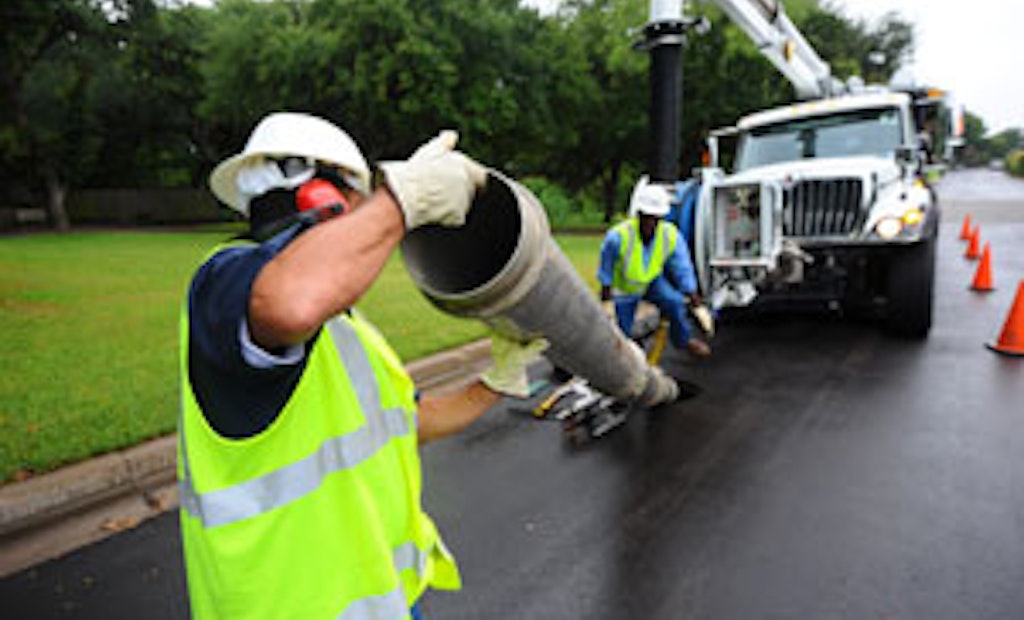
Interested in Cleaning?
Get Cleaning articles, news and videos right in your inbox! Sign up now.
Cleaning + Get AlertsHands-on control of maintenance and well-organized inter-active divisions have enabled the Fort Worth (Texas) Water Department to overcome SSOs caused by grease, inflow and infiltration, and root intrusion.
These are familiar challenges for many municipalities, but what separates Fort Worth from other large cities is the size of its maintenance program, coupled with a $232 million Wet Weather program that upgraded the collection system. The city has gone from 1,415 SSOs per year in 1998 to 82 in 2009.
Such success attracts officials from around the Southwest, who come to look and learn. The success also extends to treatment oper-ations: In 2010, the city received the Platinum Peak Performance Award from the National Association of Clean Water Agencies, recognizing the treatment plant for 20 consecutive years of operation without permit violations.
Managing FOG
With a population of 736,000 spread over 350 square miles, Fort Worth is the 17th largest city in the nation. The Field Operations Division manages 3,400 miles of 6- to 96-inch concrete, vitrified clay and other types of sewer lines, 28 lift stations and 75,000 manholes. To manage the work, the division divided the city into 360 subareas, each with 40,000 to 50,000 feet of pipes that are analyzed on a ro-tating schedule, their conditions ranked, and work prioritized.
The strategy resulted from a 1993 U.S. EPA administrative order. The city completed its Wet Weather I&I reduction program in 2001, a year ahead of schedule, and now maintains those efforts with a staff of 446.
Maintenance issues focus on grease, I&I and root intrusion. “Our grease comes from dense populations, such as apartment complexes,” says Rick Davis, wastewater collection system superintendent. “Consequently, we have a strong public education program that includes inserts in utility bills, door hangers and vignettes on our local cable channel about keeping grease out of the sewers.”
Before Thanksgiving and Christ-mas, the Pollution Control Division Pretreatment Section ramps up the campaign, encouraging residents to pour cooking grease into a jar or can, add cat litter to solidify the fat, and place the container in the trash. They even set out grease collection containers during holidays.
“We also have a strong pretreatment program run by the pretreatment group,” says Davis. “They inspect and sample restaurant and industrial flows, permit the industries and size restaurant grease traps. While we’ve looked at some new grease trap products, the old reliable two-chambered trap works best for us.”
Nevertheless, pretreatment can’t address all the grease issues. Some areas have high concentrations of restaurants, and some pipes have bellies that accumulate grease.
When blockages or complaints alert Field Operations, crews remove hard blockages caused by grease or roots with sewer jetting trucks and circular hydraulic-powered saws, or a modified flexible chain cutter that does not damage pipe walls.
“My crew redesigned the skids on two KEG Super Cutters,” says Kirit Patel, assistant superintendent of the Preventive Maintenance (PM) Section. When clearing grease, a flusher truck follows the jet truck, working manhole to manhole to degrease the line and adding Magnum Flow III chemical formulation from Municipal Industries Inc.
No excuses
The city hires contractors to clean and inspect all lines larger than 24 inches. It also insists that every line of any size is inspected from manhole to manhole. “We don’t accept excuses,” says Patel. “This approach has helped us locate many root problems before they could cause backups.”
Root intrusion is prevalent in the older part of the city, where shallow sewers run beneath alleys or across easements heavily planted with trees and shrubs. After the Sewer Section selects the areas for cleaning, the staff uses Maximo asset management software from IBM to generate work orders to the PM Division.
“We insist they inspect the cleaned lines to verify that all the major roots are gone,” says Patel. “A month or two later, we hire a company to foam the pipes with Razorooter II, a diquat-based herbicide from Duke’s Root Control.”
After an area has been treated, it is monitored for customer complaints and backups. “Crews also return periodically and do quality assurance/quality control to make sure no roots are growing,” says Patel. “Root control is a significant part of our sewer program. We clean and treat about 500,000 feet per year.”
Proper tools
Before the Wet Weather program, the city had three inspection crews but no combination machines. Today, it has nine combination trucks from manufacturers including Vactor, Hi-Vac and Jet-Vac.
Also in the fleet is one sewer flusher with a Jet Eye inspection system from PipeHunter. The truck enables cleaning and inspection of a sewer line in a single operation: Crews can see what is happening in the line during the cleaning process and detect problem areas.
“The flusher truck never stops running,” says Patel. “Part of the reason is Paul Kristynik, who maintains all our camera equipment and some of the combination units. Keeping the work in-house saves us a lot of time and trouble.”
The Sewer Division cleans 1.2 to 1.5 million feet of pipe per year and inspects it with eight camera vans from CUES and one from Aries Industries. Workers also use GatorCam3+ inspection systems from Radiodetection for smaller pipes. The videos are analyzed daily by technicians in the Field Operations Technical Section.
While asset management software is essential, Field Operations is proud of how seamlessly the various sections work together. “We team the vacuum truck crew with the TV crew and work out the whole system simultaneously,” says Patel. “We also send a support crew with them to help solve access issues. They do whatever it takes to inspect 100 percent of the pipe from manhole to manhole.”
Condition assessment
After the Sewer Section identifies structural problems in pipes, it recommends spot repairs, CIPP lining or replacement with PVC pipe. “When we do a master plan, we look at the pipes’ condition and criticality,” says Davis. “Age doesn’t necessarily mean that the pipe is bad, as we’ve found some old pipe in better shape than newer ones.”
The department uses a rating system to rank projects from 1 (very good) to 5 (needing immediate attention). “Point repairs or maintenance on number 4 pipes will give us a couple more years of service,” says Patel. “We constantly monitor 1, 2 and 3 conditions to watch for deterioration.” Reports go out to various divisions and sections as soon as crews complete the cleaning and inspections.
While Field Operations designs the sewer maintenance program, it coordinates with Engineering and Fiscal Services for new sewer designs and line replacements. The city replaced 18.4 miles of pipe in 2009. Designs for rerouting sewers are contracted to engineering firms.
“If the city tears up a street, our Engineering and Fiscal Services coordinates with the city’s Transportation/Public Works De-partment to replace the water and sewer lines simultaneously if required,” says Davis. “We also have numerous new major road projects calling for us to relocate and upgrade large-diameter lines.”
Travis Andrews, Water Department assistant director in Field Operations, is proud of how effectively the staff attacks problems to maintain the system. “They’re using technology, sophisticated analysis, and their combined expertise to target our limited resources efficiently, and we’re getting results,” he says.










